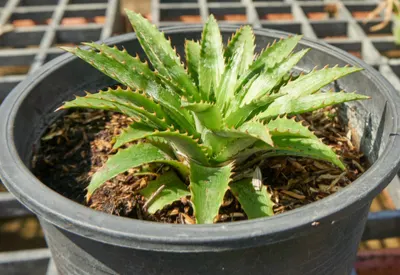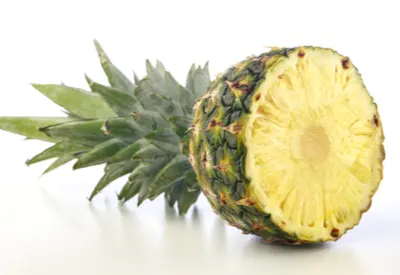Think its impossible to grow pineapple plants if you don’t live in a tropical area? Think again! It’s actually quite easy, especially if you grow them in containers.

A young pineapple plant growing in a container
Many folks mistakenly think pineapples come from trees. They are, however, a perennial plant. And although they need warmth to survive, they can be grown almost anywhere. Even in climates with cold winters.
All you need to do is grow them in containers. They make a great over-wintering house-plant. And an even better summertime patio planter.
Pineapple plants grow and mature slowly. It can take between two to three years before a plant will produce its first fruit. Each spiked plant produces a single, lone pineapple. After fruiting for its first time, plants will continue to produce a new pineapple on an every other year basis. For most pineapple plants, you can get three “harvests” before the plant finally begins to fade.
Now if you are lucky enough to live in Growing Zones 11 or 12, you can try your hand to grow pineapple plants outdoors, the whole year round. However, for the large majority of folks who live in cooler climates, growing pineapples can still be possible by planting in containers. It allows for plants to be moved indoors in the winter to protect from freezing. When the warm temperatures return, plants can go back outdoors and flourish. If nothing more, it can add a feel of the tropics wherever you live!
How To Grow Pineapple Plants – Container Style
Although you can grow pineapple plants from seed or small transplants, one of the easiest ways to start is from the top of pineapple. Product Link : White Jade Pineapple Plants
Begin by purchasing a healthy, ripened pineapple. Be sure to select one that looks deep in color and thoroughly ripened. Avoid selecting any damaged or decaying fruit.
Using a sharp knife, cleanly cut the top 2″ of the pineapple off. Remove the bottom few inches of leaves from the bottom of the shoot area. This will be approximately 6 to 8 leaves.
Now its time to let the pineapple cutting rest. Set the pineapple top on a paper towel or paper plate and let it sit for 7 to 10 days. This allows the cutting to cure and begin to set the rooting nodules. It is these nodules

One of the easiest ways to grow your own pineapple plants is from a pineapple top.
After the plant has cured, plant the cutting in a coarse potting soil that is well drained. You can purchase cactus potting soil mix, or create your own with a bit of potting soil, coarse sand, peat, and perlite. Plant the crown portion of the pineapple about and inch and a half down in the soil mix. It is usually best to start the plant in a smaller 8 to 10″ pot. This makes it easier to keep moisture levels regulated as the plant roots into the soil. Rooting can take anywhere from 8 to 12 weeks. Product Link : Cactus Potting Soil
Place in a warm sunny location that receives at least 6 to 8 hours of full sunlight each day. When the threat of frost or winter approaches, move your pineapple plant indoors to a sunny, southern facing window.
Water throughout the entire growing process at an extremely light rate. Over watering is far more detrimental to pineapple plants than not enough moisture. Allow soil to nearly dry out almost completely in between watering.
Potted plants grow to 2 to 3 feet in both width and height at full maturity. To handle the full growth cycle, plants should be grown in a minimum of 5 gallon containers as they approach full size.
It is best to transplant from the smaller starting pot to the larger pot after a year’s growth. Pineapple plants do not require much to live beyond water. You can apply a bit of all purpose fertilizer or even worm castings every other month. Keep fertilizing to the bare minimum, much like over watering, more is not better.
Here’s to growing your own pineapple plant this year!
Be A Contributor To This Is My Garden

A beautiful pineapple plant
Want to showcase your backyard garden on This Is My Garden? Perhaps you have a few tips on vegetable or flower gardening. How about becoming a contributing editor to This Is My Garden and share your story.
Simply email us at info@thisismygarden.com, and your garden or garden tip might be our next feature!
Help make This Is My Garden the best garden site around and share your garden knowledge with fellow gardeners! This article may contain affiliate links.
